- Most of the ammonia emitted from an agricultural activity will be deposited close to source, within a few kilometres. A smaller proportion is dispersed further away.
- Ammonia emissions vary significantly across the landscape with point sources, such as animal houses and manure stores, and diffuse sources, such as manure spreading in fields, forming a patchwork of emission sources across the countryside.
- Ammonia emissions to the air vary over the course of the year as they are driven by seasonal agricultural practices, e.g. fertiliser and manure spreading periods, and weather conditions, particularly temperature and wind speed.
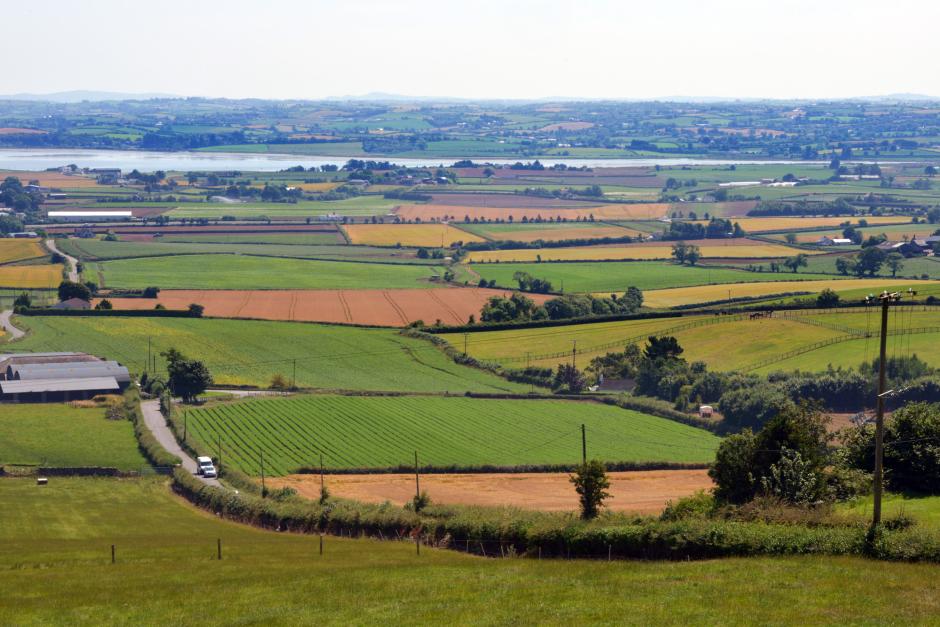
Ammonia concentrations vary greatly across the rural landscape as ammonia is quickly dispersed and deposited away from sources. At sites with no immediate local ammonia sources, such as Lough Navar, Co Fermanagh, the annual average concentrations of ammonia are around 0.5 µg m-3 in the background atmosphere (uk-air.defra.gov.uk).
Note, 1 µg m-3 = 1 millionth of a gram in 1 cubic metre of air.
Levels of atmospheric ammonia within farming landscapes are much higher. For example, the annual average concentration of ammonia at the long-term National Ammonia Monitoring Network (NAMN) site on AFBI’s Hillsborough Farm land is 2.68 µg m-3 (reference below).
Figure 1 summarises the variation in the monthly average ammonia concentrations at difference source classifications (pigs & poultry, cattle, sheep and background) across the UK (reference below).
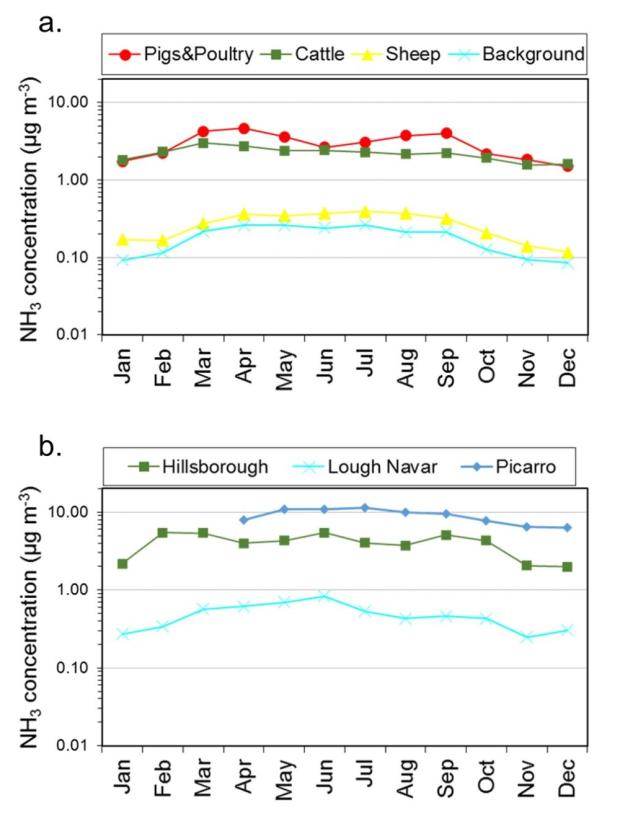
Figure 1.
a) Comparison of seasonal trends in NH3 (monthly means for 1998 to 2014) of sites from the UK National Ammonia Monitoring Network (NAMN) classified into four key emission source categories: cattle, pigs & poultry, sheep and background (taken from Tang et al. 2018).
b) Comparison of seasonal trends from the two NAMN sites in Northern Ireland, Hillsborough (classification: cattle) and Lough Navar (classification: background) compared to the average monthly concentration of NH3 measured at Hillsborough using the Picarro instrument (continuous, minute-by minute data) in 2019. Note the concentrations are on a log scale and the Picarro instrument is closer to the major farm NH3 sources than the Hillsborough NAMN site.
Reference: Tang, Y. S., Braban, C. F., Dragosits, U., Dore, A. J., Simmons, I., van Dijk, N., Poskitt, J., Dos Santos Pereira, G., Keenan, P. O., Conolly, C., Vincent, K., Smith, R. I., Heal, M. R., and Sutton, M. A.: Drivers for spatial, temporal and long-term trends in atmospheric ammonia and ammonium in the UK, Atmos. Chem. Phys., 18, 705–733.
The monthly average concentrations reported contain a combination of periods of much lower and higher concentrations which can only been observed using an instrument that measures ammonia much more frequently than the cumulative monthly data from the NAMN.
Figure 2 shows how measurements at 30 minute intervals compare to monthly averages over both 9 month and 2 month periods at Hillsborough. Previous studies measuring at a higher time resolution have shown that concentrations can vary greatly at different sources (see Table 1 below).

Figure 2.
Comparison of the 30 minute average to the monthly average over both 9 month and 2 month time periods at the AFBI Hillsborough continuous NH3 monitoring site.
At AFBI Hillsborough, the principal sources of ammonia include:
- Fertiliser and manure applications to fields
- Anaerobic Digester (AD)
- Livestock housing
- Manure heaps and slurry stores
Ammonia concentrations measured in the vicinity of agricultural emission sources at a high-frequency time resolution can be greater than 1000 µg m-3 especially when measured close to the source (Refer to Table 1 for references to monitoring studies elsewhere).
The weather also plays an important role in determining ammonia concentrations at high time resolution:
Wind speed:
- Determines the rate of dispersion of the ammonia from the source. At a low wind speed there is reduced dispersion and so higher concentrations are reported. Under high winds, emitted ammonia is rapidly dispersed and local atmospheric concentrations are lower. Figure 3 from the Hillsborough continuous monitoring site demonstrates this, where the lowest wind speeds result in some of the highest reported concentrations.
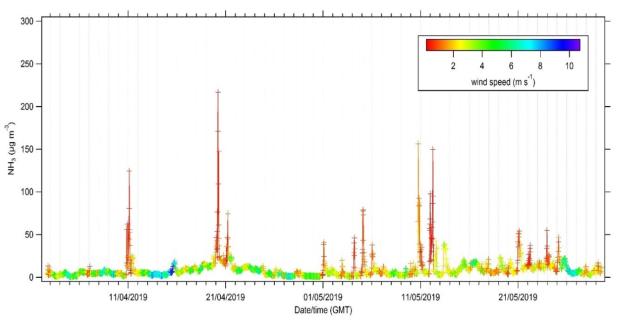
Ammonia (NH3) concentrations measured at Hillsborough farm coloured by wind speed in April and May 2019.
(Note: Provisional data).
Wind direction:
- The direction of the wind will help to identify if the observed ammonia concentrations are from the farm’s activities or being transported into the site from elsewhere. Figure 4 shows the average ammonia concentration grouped for each wind direction and wind speed at Hillsborough. It is clear that higher concentrations generally come from the south-westerly direction at the site. This is because major sources at the Hillsborough Farm, such as the anaerobic digester and many animal houses, are located in this wind sector (Refer to Figure High Resolution Ammonia Monitoring at AFBI Hillsborough).
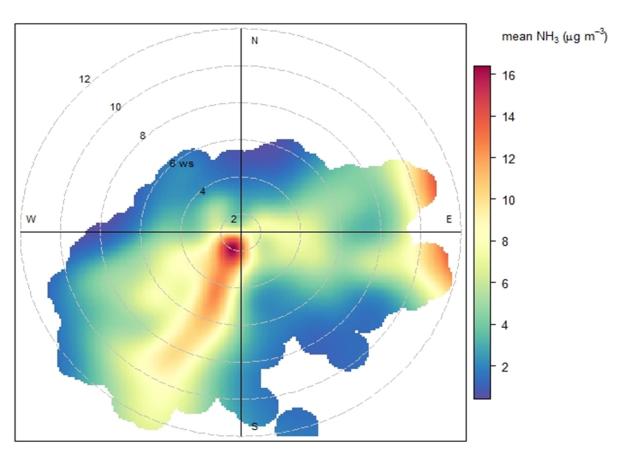
Polar plot showing the average ammonia (NH3) concentrations for each wind speed and wind direction for the period of the 02/04/19 to 19/12/2019.
(Note: Provisional data, where wind speed below 1 m s-1 removed).
Rainfall
- Ammonia is water soluble. High rainfall events can reduce measured ammonia concentrations as the ammonia will be washed out by the rain and deposited to the ground as ammonium (NH4+) in solution in rainwater.
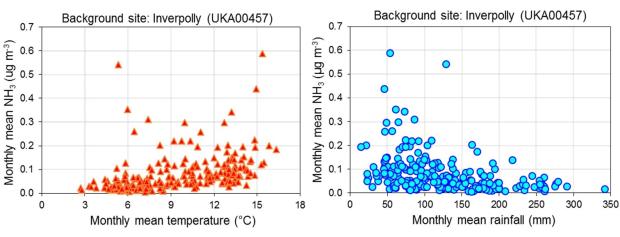
NH3 was negatively correlated with rainfall (blue) and positively correlated with temperature (red).
Adapted from Tang et al. (2018)
Table 1. Summary of references of reported ammonia concentrations from different sources
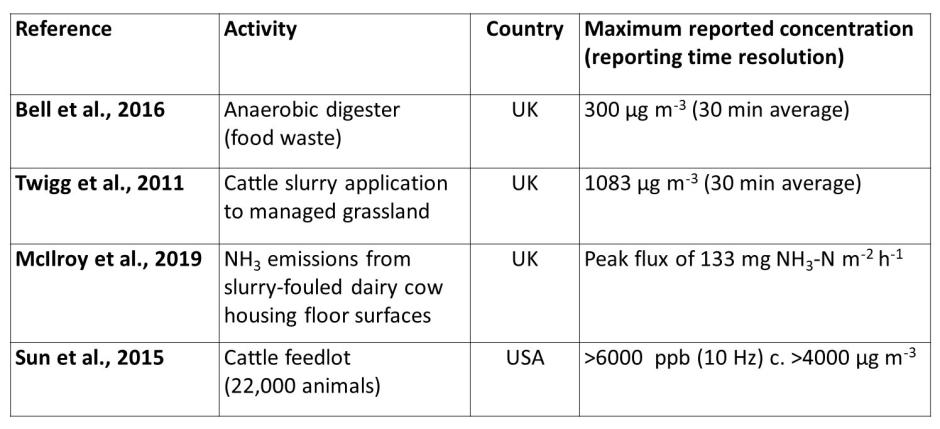
Table References:
Bell, M.W., Tang, Y.S., Dragosits, U., Flechard, C.R., Ward, P. and Braban, C.F., 2016. Ammonia emissions from an anaerobic digestion plant estimated using atmospheric measurements and dispersion modelling. Waste Management 56: 113-124.
McIlroy, J., McGeough, K., Laughlin, R., Carolan, R. 2019. Abatement of ammonia emissions from dairy cow house concrete floor surfaces through additive application. Biosystems Engineering 188: 320-330.
Sun, K., Tao, L., Miller, D.J., Zondlo, M.A., Shonkwiler, K.B., Nash, C. and Ham, J.M., 2015. Open-path eddy covariance measurements of ammonia fluxes from a beef cattle feedlot. Agricultural and Forest Meteorology 213: 193-202.
Twigg, M.M., House, E., Thomas, R., Whitehead, J., Phillips, G.J., Famulari, D., Fowler, D., Gallagher, M.W., Cape, J.N., Sutton, M.A. and Nemitz, E., 2011. Surface/atmosphere exchange and chemical interactions of reactive nitrogen compounds above a manured grassland. Agricultural and Forest Meteorology 151 (12): 1488-1503.